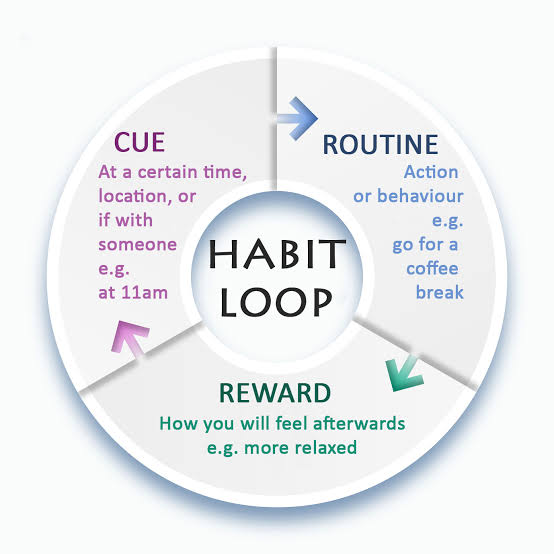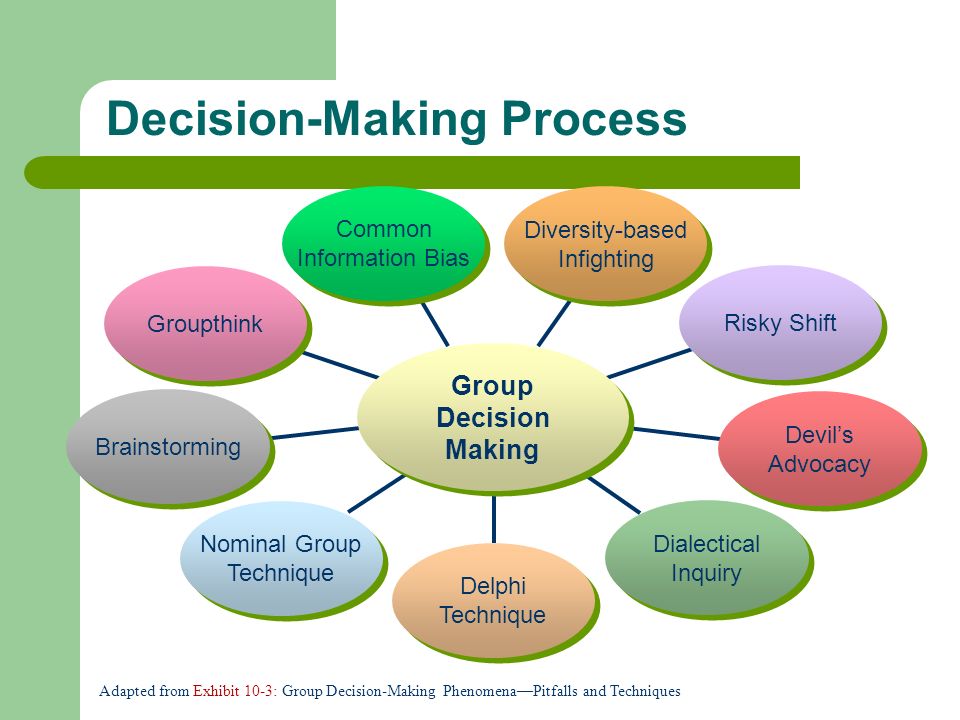How to detach from someone with borderline personality disorder
How to Deal with Borderline Personality Disorder
Happiness as in “feeling present and fully engaged” requires many skills and an open-hearted way of life, which is quite the challenge for most people. Many people are lonely and our culture often fails us in our pursuit of happiness. For those who suffer from Borderline Personality Disorder (BPD), the challenge is even greater. The good news is, usually the symptoms of BPD lessen over time, especially when the person is supported in psychotherapy and psychiatry.
In all honesty, I do believe that we can be too unhappy to be happy, even though it is astounding how suffering changes once we take an honest look at ourselves. Acknowledging our rigidities allows us to face and embrace our suffering, do what we can, and surrender when there is nothing further to be done. With kind attention, we are likely to allow happiness into our lives despite intense, inner obstacles.
While this blog post is foremost for those who are connected with someone who suffers from BPD, I must mention here how important it is to diagnose this disorder accurately. It is notoriously difficult to differentiate between BPD and Bipolar disorders.1 I highly recommend reading the excellent article I have included in the references below. For example, the authors of this article, Robert S. Biskin and Joel Paris, remind everybody that the erratic behavior in BDP is not as much tied to ongoing and longer mood swings, but to problems occurring in relationships.
Recognizing the Symptoms of BPD
People who have BPD often suffer, but so do the people around them. It is hard to be present-minded when one is barraged by another person’s aggressive, impulsive, and/or chaotic behavior. It is easy to get hurt by someone who explodes in anger and contempt. Let us look at the symptoms of BPD before I make suggestions for how to respond to or become proactive with someone who is borderline.
Those with BPD have a pervasive pattern of instability in three main areas of life: interpersonal relationships, self-image, and affect. They act impulsively from a young age, even though we can only diagnose this disorder once the person is 18 years old.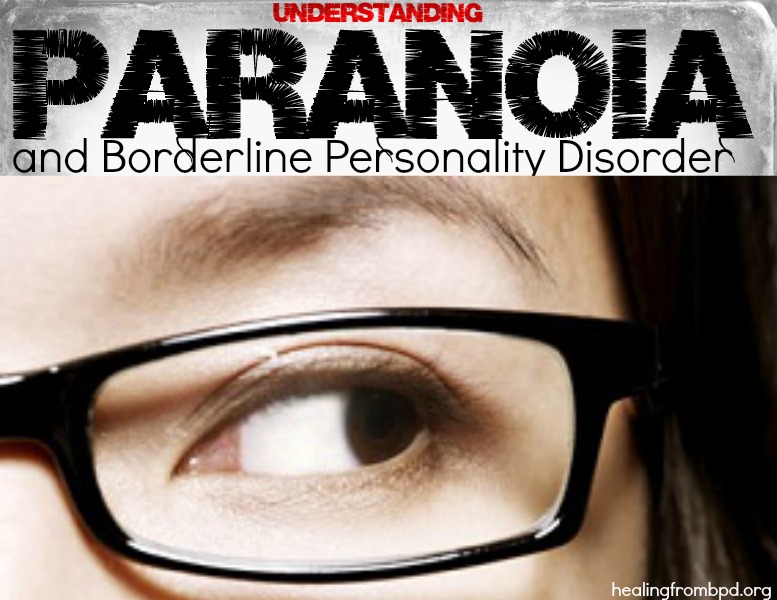 According to the DSM-52, the manual used to help diagnose psychiatric disorders, a person with BPD must meet at least five of the following criteria:
According to the DSM-52, the manual used to help diagnose psychiatric disorders, a person with BPD must meet at least five of the following criteria:
- Frantic efforts to avoid real or imagined abandonment (other than covered by criterion 5).
- A pattern of unstable and intense interpersonal relationships characterized by alternating between extremes of idealization and devaluation.
- Identity disturbance: markedly and persistently unstable self-image or sense of self.
- Impulsivity in at least two areas that are potentially self-damaging, for example, spending, sex, substance abuse, reckless driving, binge eating (other than behavior covered in criterion 5).
- Recurrent suicidal behavior, gestures or threats, or self-mutilating behavior.
- Affective instability due to a marked reactivity of mood, for intense episodic dysphoria, irritability or anxiety usually lasting a few hours and only rarely more than a few days.
- Chronic feelings of emptiness.
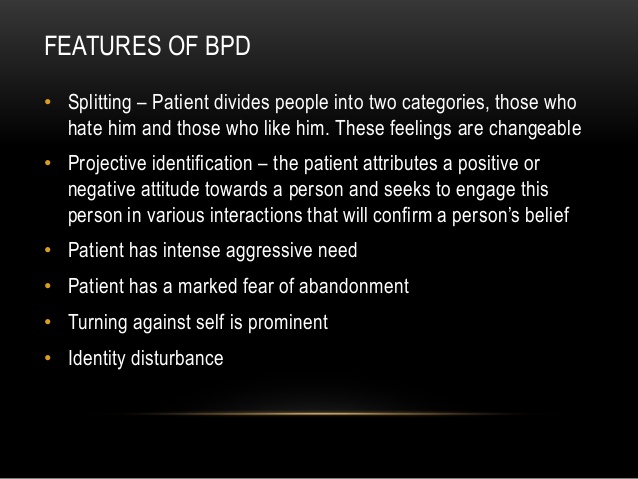
- Inappropriate, intense anger or difficulty controlling anger, for example frequent displays of temper, constant anger, and recurrent physical fights.
- Transient, stress-related paranoid ideation or severe dissociative symptoms.
It is often exhausting having to prove to someone who suffers from these symptoms that they are worthy and wanted. Young adults who feel empty and scared of becoming abandoned by their parents, for example, tend to test and provoke their parents to find out if they are truly valued. The testing period seems to never end, albeit there could be brief periods of peace after an aggressive outburst. Females tend to act out the aggression against themselves with self-harm and suicidal ideation; males are more likely to externalize and act out the aggression against others or things.
When there is the slightest suspicion that the person with BPD is not valued, the borderline person quickly falls to intense reactivity, accusing the other of intentionally undermining him or her. He or she might try to punish the other to make him or her stop the alleged neglect or hostility. Without even noticing, the person with BPD might successfully transfer his or her chaotic state to the other, meaning that suddenly the other might feel even worse than the one who has this disorder. This can be very painful, where it is hard to function and enjoy life.
He or she might try to punish the other to make him or her stop the alleged neglect or hostility. Without even noticing, the person with BPD might successfully transfer his or her chaotic state to the other, meaning that suddenly the other might feel even worse than the one who has this disorder. This can be very painful, where it is hard to function and enjoy life.
Your borderline son or daughter might say hateful things. A borderline husband might break things, become physically abusive and/or threaten with dire consequences if the other is perceived as being disloyal or dismissive. A borderline wife might lose her temper in a split second when she feels disappointed, screaming loudly or threatening to hurt herself or others. What is there to do?
How to Navigate Relationships with People with BPD
1: Leave the abuser. When there is physical abuse of any kind and/or ongoing emotional abuse, one should not stay in a relationship. However, this is not always possible when the person with BDP is a close family member or an affiliate on a job site.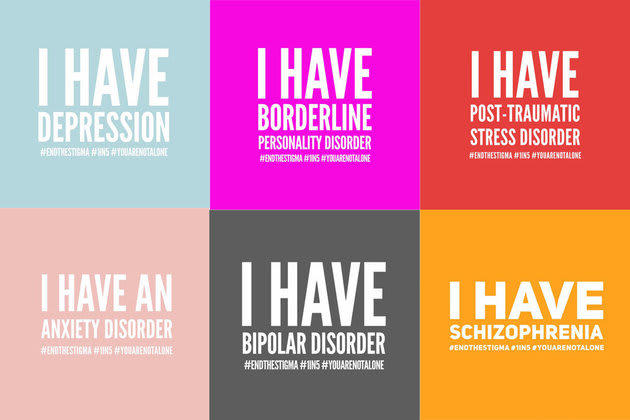 Be deliberate about any steps you consider. Your safety comes first.
Be deliberate about any steps you consider. Your safety comes first.
2: Do not try to endure your suffering alone. Seek support. It is important to seek help to stop the abuse and the chaos. Your own happiness and the happiness of the one who suffers from BPD are at stake. It is our sacred duty to interrupt abusive patterns, to act and detach. We might have to consult with a psychotherapist or make contact with a treatment center.
Don’t let certain ideas stop you, such as thoughts about being a failure or “One should not air dirty laundry in public.” Shame can be a huge obstacle to reaching out and confiding in others who are in the position to help. In the name of happiness and your right to be happy, do not let shame stop you.
3: Set boundaries. There is hardly anything as effective as setting crystal clear, hard boundaries with a person who suffers from BPD. Instead of reacting emotionally, maybe by increasing the volume of your voice or crying, calm yourself.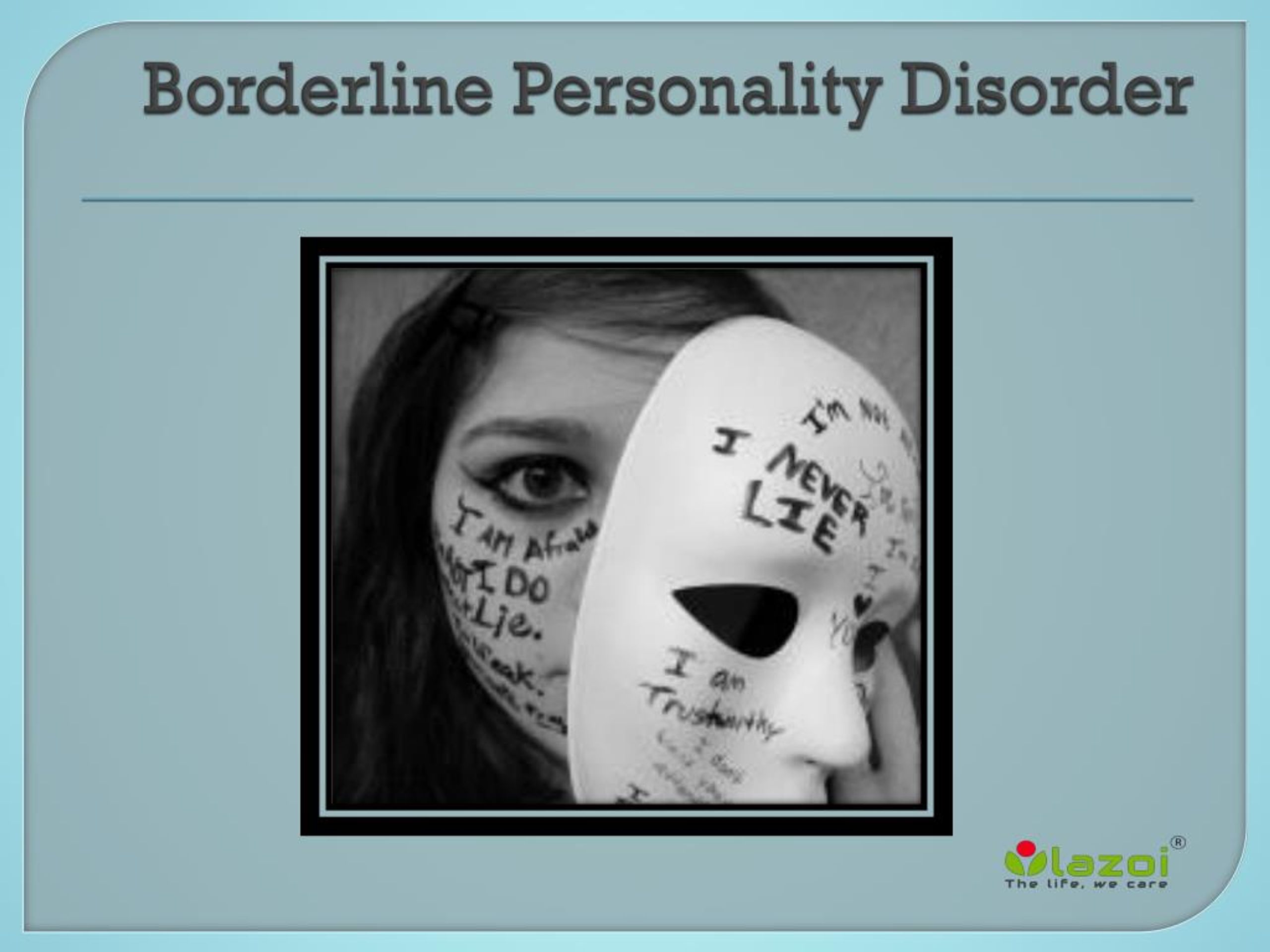 Allow yourself to become all reason, cold and collected, stating that the behavior of the other will not be tolerated. This is especially the case when it comes to your child. Saying “No” and stating your expectations is of the utmost importance.
Allow yourself to become all reason, cold and collected, stating that the behavior of the other will not be tolerated. This is especially the case when it comes to your child. Saying “No” and stating your expectations is of the utmost importance.
4: Help address “emptiness.” Without becoming the therapist of the one with borderline symptoms, talk about the underlying feelings that so often throw him or her into darkness. Discuss what is but a feeling of emptiness and look at the feeling together. This discussion must happen when all is calm. Thinking about feelings helps put distance between the experience, which is helpful when negative experiences seem to override every other part of consciousness.
5: Offer reading materials about BPD. The person who has BPD is much better off being informed of the diagnosis and what treatment interventions exist. Usually things do not get worse when one is in the “know” but the search for coping skills can begin.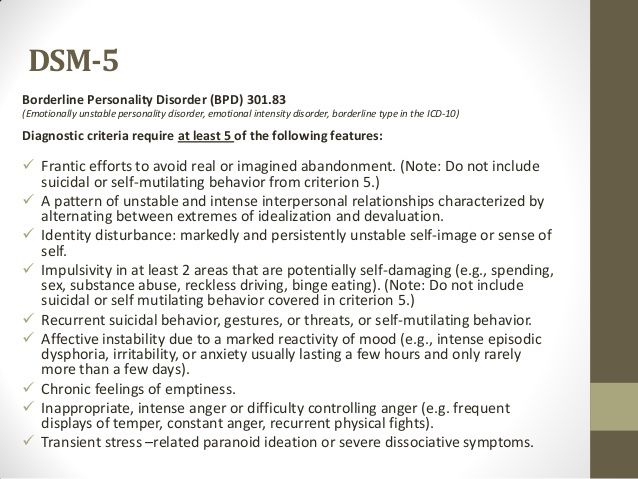
6: Practice extreme self-care. People with BPD are exhausting as they tend to cross your boundaries. Make sure you nourish yourself and eat healthily. Take meaningful breaks (probably not online). Talk to your friends. Go for extra walks with your dog. Join a gym. Live a little! Take the time to strengthen yourself with meditation and focus on your breath or healing sounds. Notice where you begin and the other ends. Learn to notice when you identify with the “bad person” you are alleged to be. Learn to reject the identification, using affirmations, for example.
It is never too late to be kind to yourself and refocus your attention. Do not let anybody rob you of the space needed to participate fully in your life. Your happiness matters.
© 2021 Andrea F. Polard, PsyD. All Rights Reserved.
How To Detach From Someone With Borderline Personality Disorder
Detaching someone with borderline personality disorder can be one of the most challenging things you will ever do.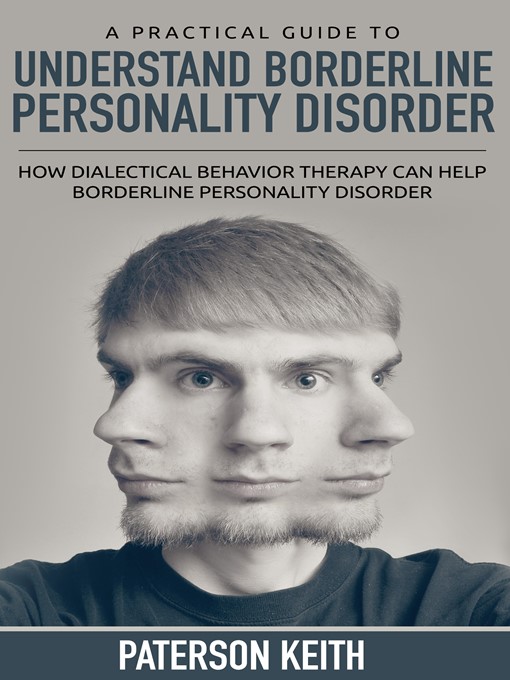 It can sometimes seem impossible, especially if you are still deeply in love with this person.
It can sometimes seem impossible, especially if you are still deeply in love with this person.
If you have found yourself in this situation, please know that you’re not alone and that there are ways to detach and end the negative cycle of codependency that you have been trapped in.
Here are some tips to help you detach from someone with borderline personality disorder
Understand Borderline Personality Disorder
Suppose you have a loved one who has a borderline personality disorder, or BPD. In that case, that person’s actions can be extremely frustrating and even terrifying.
If they say they’re going to do something and don’t follow through, it might feel like you never know what to expect. Add an overdose of raging emotions and an unhealthy amount of self-loathing into that mix, and it can seem like there is no way out.
Although people with BPD do not intentionally seek out hurtful behavior, they’re often incapable of controlling their own emotions leaving family members feeling utterly powerless in their presence.
Make Contact
It can be challenging to detach from someone who has a borderline personality disorder (BPD). Borderlines tend to be passionate and overly emotional.
They often struggle with intense feelings of emptiness. At times, borderlines act out of character and in ways that are manipulative or disruptive.
People with BPD seem like they need a lot of support. Still, in reality, it’s best for everyone involved to establish limits on how much time you’re willing to spend around them, particularly when their symptoms are flaring up.
If a loved one is diagnosed with BPD, limit contact during those flare-ups, so you don’t get pulled into their cycles of chaos.
Stay Safe
A person with BPD may engage in unhealthy behaviors such as substance abuse, sexual promiscuity, shoplifting or self-injury.
While these actions are typically intentional, it can be easy for friends and family members to become stressed by their loved one’s behavior.
Try not to take your loved one’s actions personally; remember that they are suffering, which is why borderline personality disorder is often considered a severe mental illness.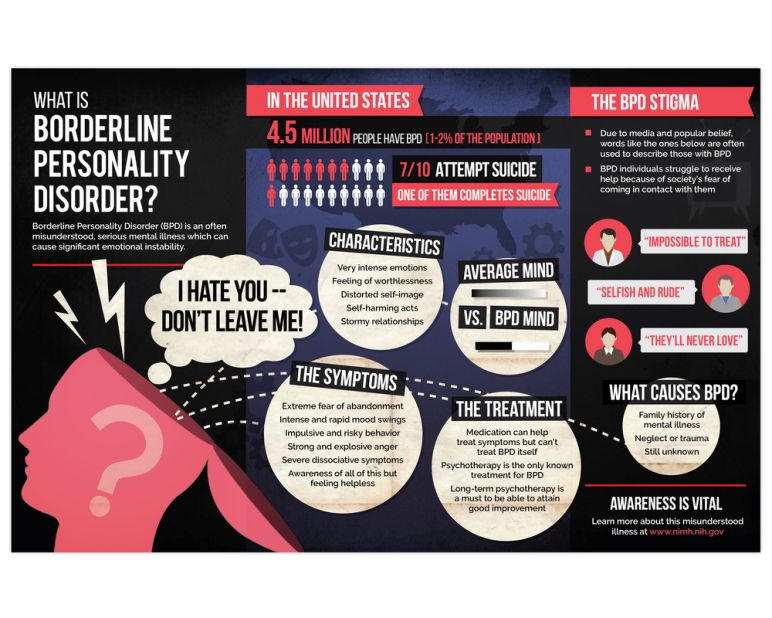
It’s essential to keep yourself safe while trying to help your loved one improve. If you have any concerns about violence, contact local law enforcement immediately.
You might also want to seek individual therapy if you feel overwhelmed or anxious about caring for someone with BPD.
Self-Care
When someone you love suffers from BPD, it can be easy to feel like you’re walking on eggshells, always looking for what might set them off next.
If your loved one’s hurting and you’ve been caring for them somehow, it’s important to remember that self-care is crucial for both of you.
And while it can be difficult, it’s also critical that you find a healthy way to detach from someone who has BPD. This doesn’t mean you don’t care about them; you need to step back so they can do their work.
This doesn’t mean abandoning your loved ones or turning your back on them when they need help.
It means taking care of yourself first so you have more energy and resources to offer them later.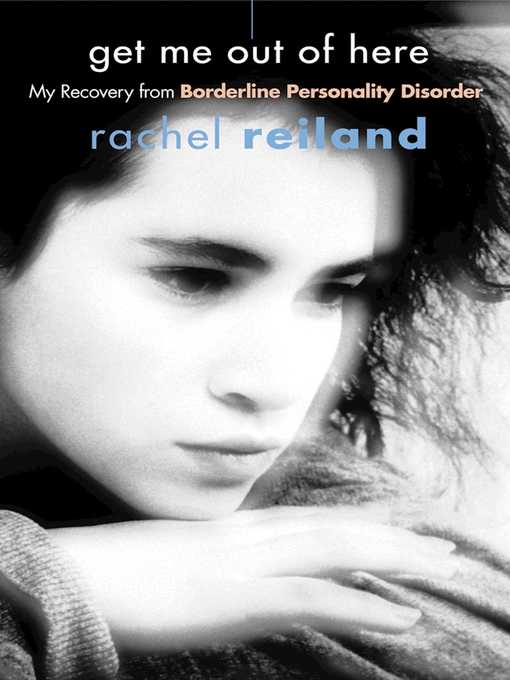 Ultimately, it will enable you to provide more support down the road and give your loved one space to heal.
Ultimately, it will enable you to provide more support down the road and give your loved one space to heal.
You’ll never learn anything if you keep going over everything repeatedly without taking time out for yourself. It’s okay if things make it hard for you to focus during meditation!
Set Boundaries
If someone you care about has a borderline personality disorder (BPD), their behaviors and attitudes might trigger your emotions.
Suppose you feel angry, agitated, confused or guilty around a person who has BPD. In that case, those emotions come from seeing them in pain and wanting to help them feel better.
However, one of the hardest things about being a caretaker for someone with BPD is knowing when and how to set boundaries for yourself.
Doing so will help prevent burnout and frustration and encourage open communication between both parties.
Suppose a person shows signs of having BPD and has not been diagnosed by a professional. In that case, they must seek out treatment before establishing solid relationships.
Seek Support
If you cannot detach from someone with BPD, get outside help. A therapist familiar with BPD can walk you through steps for creating healthy boundaries and coping strategies.
Support groups may also provide valuable guidance; experts believe family therapy can be as crucial as individual therapy when supporting someone diagnosed with BPD.
In addition, joining a support group of people with BPD (and their loved ones) will give you access to resources unique to your situation.
For example, you might find lists of helpful books or websites, tips on setting up therapy appointments (if necessary), and suggestions for dealing with everyday situations like holiday gatherings or social outings.
Even if your loved one doesn’t want treatment or support or acknowledges their condition, you should still seek professional help. This will improve your mental health and make it easier to support your loved one over time.
Conclusion
There is a fine line between helping a loved one in need and enabling bad behavior. Suppose you recognize that someone has a borderline personality disorder (BPD). In that case, there are ways you can support them while also taking care of yourself.
Suppose you recognize that someone has a borderline personality disorder (BPD). In that case, there are ways you can support them while also taking care of yourself.
You can healthily detach from them by learning more about BPD, setting healthy boundaries, creating safe environments, and talking to your loved ones about BPD. You might not always like or agree with what they do or how they treat you, but it’s their behavior, not yours.
So remind yourself of that next time you feel angry or hurt by what your loved one says or does: don’t blame yourself for their actions. If anything were to happen, there is help available for them and you if needed.
How to live with borderline personality disorder
Daria Batyrshina
lives with BPD
Author profile
I couldn't get a correct diagnosis for several years, and then it completely changed my life.
To describe borderline personality disorder, or BPD, the well-known saying of psychologist Marsha Linehan is perfect: “These people simply don't have 'emotional skin'. Even the slightest touch or movement can cause the most severe suffering.”
Even the slightest touch or movement can cause the most severe suffering.”
Share my path to getting the correct diagnosis, symptoms, and tips for dealing with people with BPD.
Go see a doctor
Our articles are written with love for evidence-based medicine. We refer to authoritative sources and go to doctors with a good reputation for comments. But remember: the responsibility for your health lies with you and your doctor. We don't write prescriptions, we make recommendations. Relying on our point of view or not is up to you.
What is borderline personality disorder
Borderline personality disorder is characterized by permanent changes in mood, self-image and behavior. This can lead to problems in relationships with other people and impulsive actions of all kinds.
BPD - Mayo Clinic
BPD - National Institute of Mental Health, USA
In the International Classification of Diseases 10th Revision, or ICD-10, there is in fact no diagnosis of "borderline personality disorder", there is an emotionally unstable personality disorder, which two types: borderline and impulsive. In ICD-11, this is already a separate diagnosis, which is called borderline personality disorder.
In ICD-11, this is already a separate diagnosis, which is called borderline personality disorder.
The disorder has several main features.
So what? 01/12/22
Transition to the new International Classification of Diseases has begun in Russia: what will change and when
Self-injurious and risky behavior. For example, a person may injure themselves or use psychoactive substances - borderline disorder increases the risk of developing various addictions.
Black and white thinking: it seems to a person that there can only be good and bad, there are no halftones.
Criteria for diagnosing BPD - Medscape
Problems with self-esteem. People with this disorder are overly sensitive to the opinions of others, enter into dependent relationships, have a strong fear of being alone, and may take desperate actions to keep a loved one or get their attention.
The manifestations of borderline personality disorder are similar to those of adolescence: outbursts of anger, mood swings, aloofness, so this diagnosis is made after 18 years.
What are the symptoms of borderline personality disorder
Alexey Pribytkov
psychotherapist, psychiatrist, Ph.D. It happened.
 For example, the partner did not respond to the message.
For example, the partner did not respond to the message. Why borderline personality disorder develops
Why borderline personality disorder develops is not exactly known.
NHS
Biological factors. There is evidence that the development of personality disorders, including BPD, may depend on genetic factors.
BPD may also be associated with changes in some parts of the brain responsible for controlling emotions. Its development can be affected by disturbances in the functioning of the system of neurotransmitters - compounds with the help of which brain neurons communicate with each other, in particular serotonin.
Social factors. For example, unstable relationships with significant adults, lack of love in childhood, neglect by parents, loss of a loved one.
Emotional or physical abuse, as well as intense fear experienced in childhood, greatly increase the risk of any psychological problems. In this case, BPD can be combined with another diagnosis - post-traumatic stress disorder, or PTSD. It is manifested by constant frightening memories of a traumatic event and increased anxiety. The more unstable the environment around and the more traumatized the child, the more likely it is to get PTSD.
How I treated depression and anxiety for several years
I first saw a doctor almost eight years ago. I had an eating disorder - it often accompanies BPD, but I didn't know about it yet.
My gastroenterologist at some point realized that my constant pains in the abdomen were most likely connected not with physical problems, but with mental ones. My mother took me to a government clinic, where I came across incompetent doctors.
/eating-disorders/
How to cure eating disorders
The psychiatrist said that I have anorexia, I look terrible and I won't be able to find a partner because "men don't throw bones." Then I realized that it was not worth waiting for help from him.
I dealt with eating disorders myself, having gone through all the stages from anorexia to bulimia and compulsive overeating in two years. After solving the problem with food, depression came. Here, I couldn't manage on my own.
My days were similar to each other: constant fatigue, apathy, I didn’t even have enough strength to eat and brush my teeth, and there was only fog in my head and no thoughts. My circle of contacts narrowed greatly, because those around me saw only aggression or received no answers at all. So several years passed, then I realized that I needed help.
On the Profi-ru website, I found a psychologist who lived next to me. Then I did not yet know how psychiatrists differ from psychologists and psychotherapists, so I did not receive the necessary help.
/psychotherapy-search/
How to choose a psychotherapist
Psychologists usually do not work with mental disorders, besides, in the sessions I just told what was bothering me, there was no other support. Sometimes I couldn't find words and we just kept silent.
I went to the specialist for about a month and paid 1300 R for each meeting. In total, we held nine meetings. The only thing I got was the fog left my head. Despite my condition and the fact that the psychologist could not do anything about it, she persuaded me to stay in therapy. She said that it helps, although I did not feel any relief.
11,700 R
I spent on a psychologist who did not help me
As a result, I did not want to spend more money on myself and lost confidence in doctors. Then I learned that in Moscow you can get free psychological help at the Moscow Service for Psychological Assistance to the Population.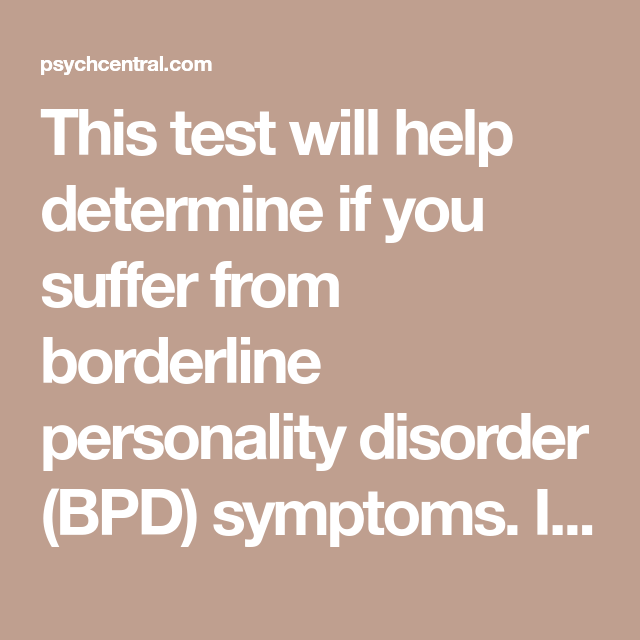
Moscow Service for Psychological Assistance to the Population
I had to wait there for an appointment, but I had nowhere to hurry. About six months later, I was able to get to a psychologist. I told her what worries me - at that time they were symptoms of depression and apathy. She immediately said that I should talk to a psychotherapist, and I made an appointment with another specialist in the same clinic.
The psychotherapist referred me to a psychiatrist, suggesting several doctors she trusts. She said that I most likely had depression and needed medication. Psychiatrists are not accepted at MSPPN, so I went to a private clinic, where I had to pay 4000 R for an appointment.
The amount of free assistance in the ISPP is limited, but it is enough to get started. Source: MSPPN A psychiatrist at a private clinic diagnosed me with depression, prescribed an antidepressant and a tranquilizer. I was lucky that my doctor saw not only in a private clinic, but also in a state one, so I went to all subsequent appointments for free.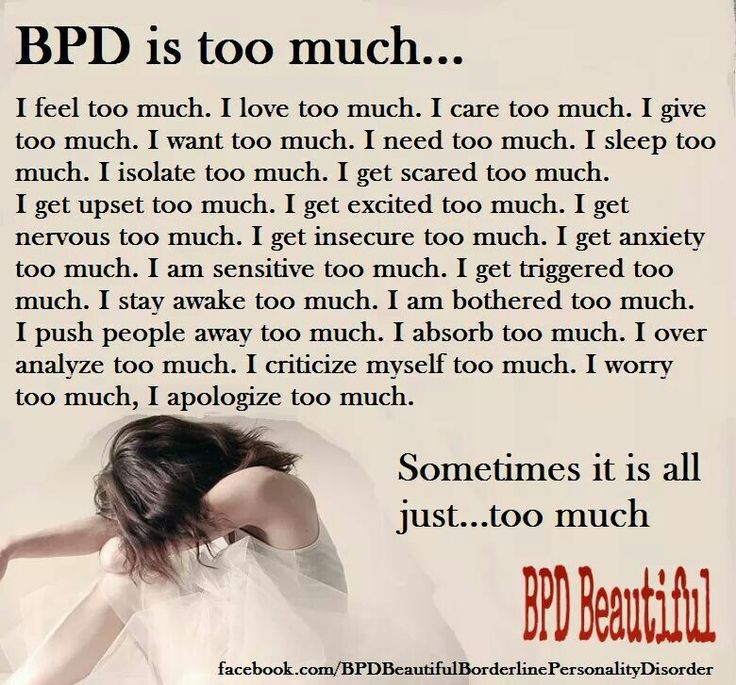
The second time I managed to find the right medicines. We fixed the changes not only with the help of conversations. The psychiatric clinic had a simulator on a computer, where the patient was asked to pass several tests: attentiveness, reaction speed, the ability to distinguish faces, and much more. I took tests at intervals of about once a month.
This testing is not necessarily and does not always reflect the effectiveness of the treatment, but I liked that the results got better every time. At that time, about 1,500 R per month was spent on medicines.
/list/antidepressant-myths/
8 myths about antidepressants
During the same period, I tried cognitive behavioral therapy. In a year I started and quit three times, nothing worked out for me. The mood diary was empty, because I do not distinguish between emotions, the diary of situations that concern me and their analysis, too. I did not understand why this or that situation became important to me. In total, I had five meetings with a psychotherapist, the cost of one was 3000 R.
In total, I had five meetings with a psychotherapist, the cost of one was 3000 R.
At that time, the doctor and I did not yet know that I had more than just depression with panic attacks and anxiety, so we did not follow my emotions and feelings much, which is important in BPD.
At some point, I abruptly stopped taking the prescribed pills and coped with the withdrawal syndrome for another week. I refused the pills, because it seemed that I could manage without them, besides, they helped for a short time, then everything started all over again.
/panic attack/
How to cope with a panic attack: recommendations from a psychotherapist
A month or two after the withdrawal, I felt fine and even started to exercise. Then anxiety and depression symptoms returned, I suffered for a few more months and went to a new doctor.
Over the next one and a half to two years, I changed three doctors in one private clinic, I was prescribed different types of medicines in different combinations and dosages.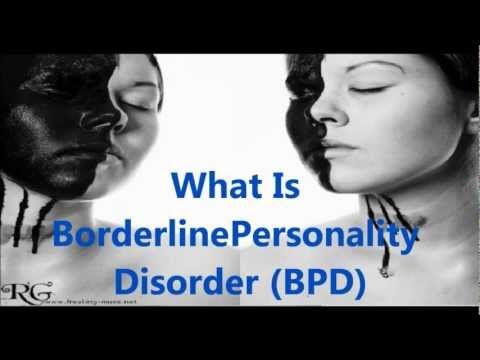 Primary appointments cost 4000-5000 R, repeated - 2400 R. I went to psychiatrists once a month to control my condition. I bought medicines either generics or original ones, they spent about 2000-3000 R per month.
Primary appointments cost 4000-5000 R, repeated - 2400 R. I went to psychiatrists once a month to control my condition. I bought medicines either generics or original ones, they spent about 2000-3000 R per month.
The pills made me feel better for a short time, about a month. During this period, I was already diagnosed with "emotional personality disorder", but they did not tell me about it. I later found out from the medical record, which I requested before changing the clinic.
At the same time, I also turned to Gestalt therapy for help - this is one of the areas of psychotherapy aimed at developing self-awareness. For me, the sessions were an opportunity to cry, acknowledge problems, and receive support. For three months, I called a psychologist every two weeks. One session cost 2000 R.
107,100 R
I spent on specialists before I was given the correct diagnosis
I spent on treatment before the correct diagnosis was made 177,100 R
| Expenses | |
|---|---|
| Medicines in the last two years of treatment | 55 000 R |
| Regular visits to psychiatrists | 50 400 R |
| Drugs in the first year of treatment | 15 000 R |
| Cognitive behavioral therapy, 5 sessions | 15 000 R |
| Three initial appointments with the following psychiatrists | 14 000 R |
| Gestalt therapy sessions, 6 sessions | 12 000 R |
| Psychologist sessions with "Profi-ru" | 11 700 Р |
| First psychiatrist appointment | 4000 R |
Medicines in the last two years of treatment
55 000 R
Regular visit to psychiatrists
50 400 R
Medicines in the first year of treatment
15 000 R
Cognitive-behavioral therapy, 5 sessions
15 000 P
Three initial appointments with the following psychiatrists
14,000 R
Gestalt therapy sessions, 6 sessions
12,000 R
Psychologist sessions with Profi-ru
R 11,7000002 Appointment of the first psychiatrist
4000 Р
How borderline personality disorder is diagnosed
Alexey Pribytkov
psychotherapist, psychiatrist, candidate of medical sciences
There are no specific studies in psychiatry that would help to make a diagnosis.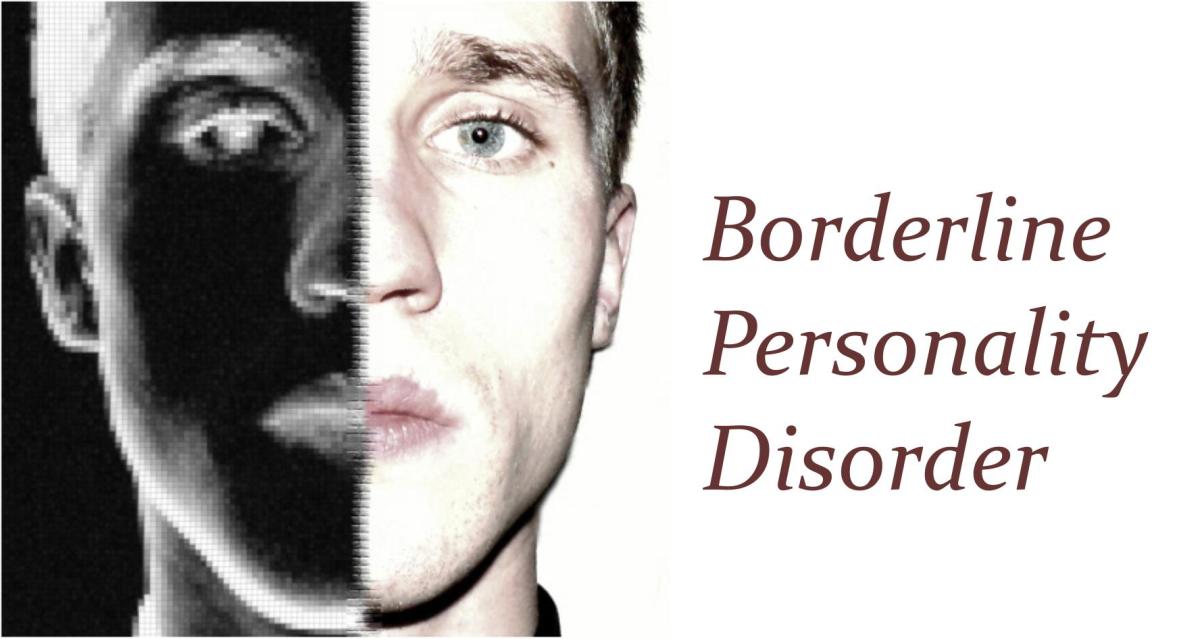 In the first place is always the clinical picture, that is, manifestations of mental disorders.
In the first place is always the clinical picture, that is, manifestations of mental disorders.
There is an interesting story with borderline personality disorder in Russia. We still use the International Classification of Diseases of the 10th revision, where in fact there is no such diagnosis, which means that for a long time it was out of sight of psychiatrists. But the absence of a diagnosis in the classification does not mean the absence of violations, because more than 30 years have passed since the adoption of the ICD-10 - it was adopted by WHO in 1990 - and the understanding of mental disorders during this period has noticeably changed.
Now many modern doctors are guided by other criteria when making a diagnosis. They are most clearly formulated in the American classification of psychiatric disorders DSM-5. Similar criteria are used in ICD-11, which is adopted by WHO and should come into force in Russia in 2024.
The nine criteria that are specific to BPD are listed above. The task of the psychiatrist is to identify them during a conversation with the patient. The basis for the diagnosis of "borderline personality disorder" is the presence of at least five of the nine criteria.
The task of the psychiatrist is to identify them during a conversation with the patient. The basis for the diagnosis of "borderline personality disorder" is the presence of at least five of the nine criteria.
How I was correctly diagnosed and treated
After many unsuccessful attempts at treatment, I decided to change doctors again and went to a new psychiatrist at another clinic. The first appointment there cost 7,000 R, and repeated appointments cost 6,000 R.
The drug treatment was corrected for me. And with the final diagnosis, they rushed between bipolar affective disorder, or BAD, and borderline personality disorder.
/bipolarnoe-rasstroystvo/
How much does it cost to treat bipolar affective disorder
They are similar in symptoms. BAD also occurs with alternating periods of depression and high spirits, but they are usually long and can last several months.
In BPD, periods of different moods change over several hours, less often over several days, that is, the mood is constantly unstable.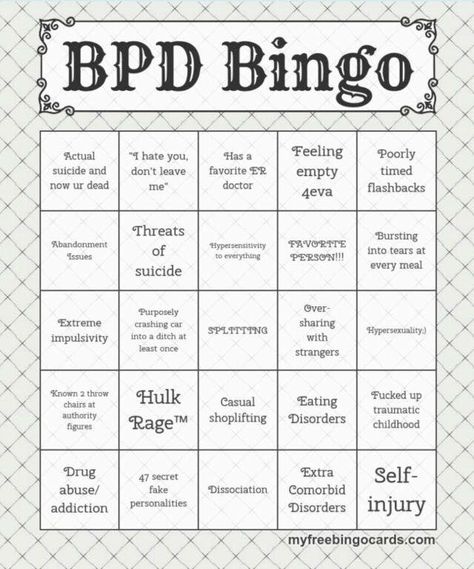 Moreover, these two disorders can occur simultaneously in one person.
Moreover, these two disorders can occur simultaneously in one person.
As a result, the psychiatrist diagnosed me with borderline personality disorder. Now, once every one and a half to two months, I go to him to monitor the condition.
Since that time, I began to go to schema therapy - this is a therapy focused on making a person change their behavior patterns. I go to a psychotherapist every week, one session costs 6000 R. I feel that it helps me.
BPD - MSD Handbook
My maladaptive patterns of behavior that my therapist and I identified at our first meeting. In the lower left corner are the schemes to be achieved It is difficult to treat BPD. My doctors never know in what condition I will come to them and whether I will come at all. Meetings are held online from time to time. I am often late, I call specialists from different places: it can be a park or my workplace, a stop on the street or someone else's apartment, a noisy highway or a food court. Sometimes I don't want to see my doctor because it seems that he is wrong about everything.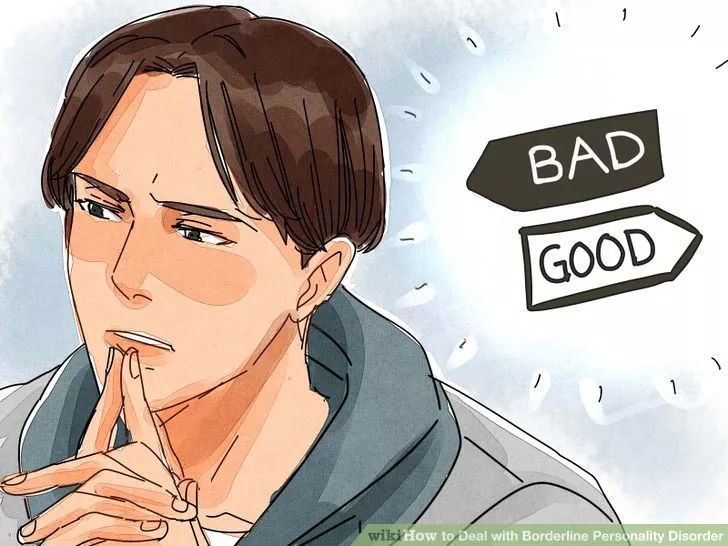
I used to feel disgusted and decided that I needed another doctor: I abruptly go from idealizing a person to hating him. For this reason, many doctors refuse patients with borderline disorder. In addition, people with BPD tend to discount their own problems, so many may not seek help for a long time.
/list/antidepressant-facts/
10 things to know before taking antidepressants
Over the years, I have developed several rules for choosing a doctor for myself:
- At the reception, they listen to me attentively.
- Everything that I consider important is important to a doctor. He should not wave his hand and say that there is no point in talking about something.
- The doctor speaks honestly about the diagnosis, does not hide anything, describes the treatment regimens.
- I am informed about the drug I will be taking. They explain exactly how it works, why it was prescribed, what side effects.
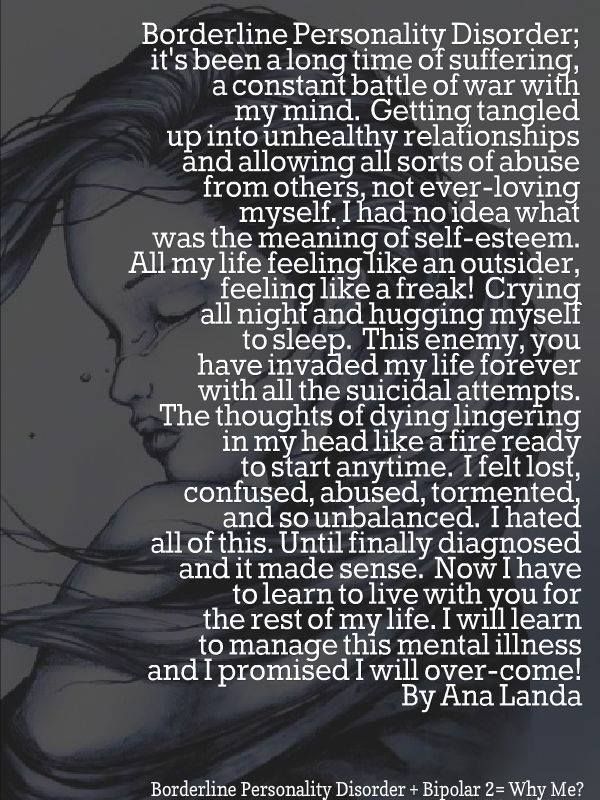
- If I don't like something, I change doctors.
Unfortunately, there are no rules that help fight mood swings. I try to turn to the facts at such moments and tell the doctors how I feel. Psychiatrists, as a rule, treat the frequent change of doctor normally. I have never faced condemnation.
One of the latest treatment regimens My prescriptions for drugs, there are a lot of them due to different dosagesHow borderline personality disorder is treated
Alexey Pribytkov
psychotherapist, psychiatrist, PhD in medicine
The main method of treating borderline personality disorder is psychotherapy. It is necessary to achieve a stable result. Medications only alleviate some of the symptoms of the disorder.
Dialectical Behavioral Therapy, or DBT, has the most evidence of effectiveness in treating BPD. Other directions can be applied: schema therapy, transference focused therapy - TFP.
However, medications are also prescribed for most BPD patients.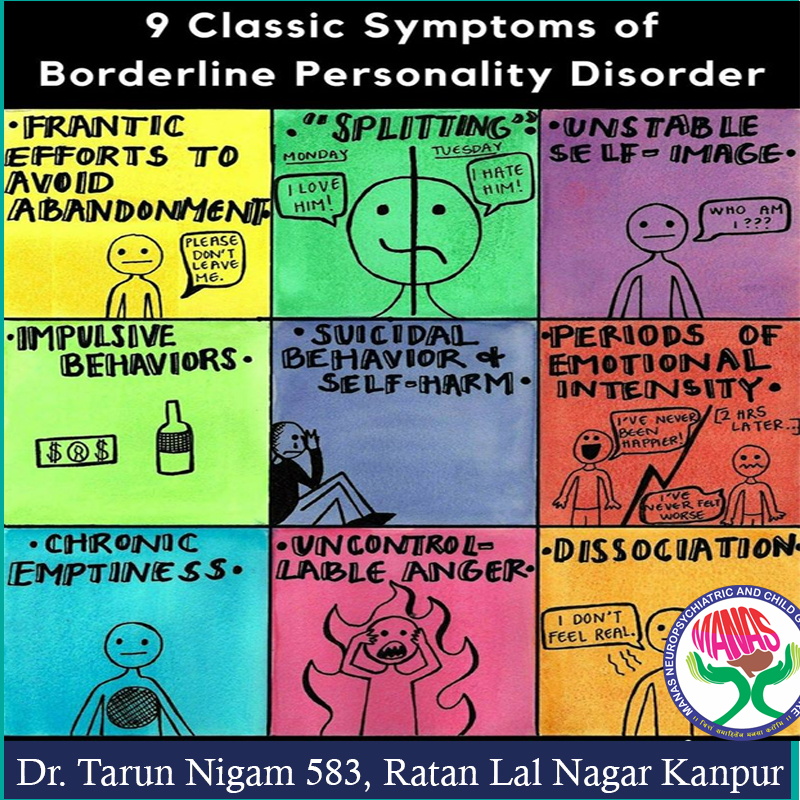 Three groups of drugs are usually used:
Three groups of drugs are usually used:
- Mood stabilizers, or mood stabilizers, are drugs that smooth out emotional fluctuations and help maintain an even mood.
- Antidepressants - they help reduce the severity of emotional instability. BPD often accompanies depressive and anxiety disorders, obsessive-compulsive disorder - antidepressants are also used to treat them.
- Antipsychotics, or second generation antipsychotics, are prescribed in low doses to correct impulsivity and aggression.
The choice of treatment regimen depends on the symptoms of the individual patient. Drug therapy usually lasts at least a year, more often several years.
How do I deal with borderline personality disorder
Insomnia. I have suffered from sleep problems since childhood. I tried everything: from hot milk at night to being very tired during the day.
Unfortunately, I don't have a universal solution to this problem. I only save myself with pills: psychiatrists prescribed tranquilizers for sleep, now I have an antidepressant with a strong sedative effect - or I just don’t sleep.
I only save myself with pills: psychiatrists prescribed tranquilizers for sleep, now I have an antidepressant with a strong sedative effect - or I just don’t sleep.
/insomnia/
How to deal with insomnia
Anxiety and panic attacks. It often overtakes unexpectedly and at the most calm moments. Just talking to a friend, I can start twitching my leg, nervously breaking my nails, scratching my skin with my nails, or sticking to my phone. This is also manifested by a rapid heartbeat, trembling in the body, a desire to move, and strong fear.
To get rid of this feeling, I knit, switch to TV series, listen to meditation practices, start moving more, turn to metaphorical associative cards or Tarot. Metaphorical associative cards are cards with pictures that you can interpret based on your experience.
I use cards when my anxiety is about the future. I am extremely afraid of uncertainty, and this is a chance to decide at least a little, albeit somewhat irrational.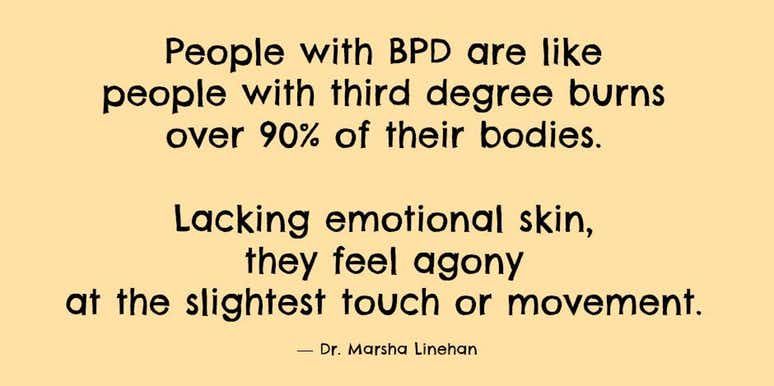
Feeling alone and abandoned. Feels like an unfilled hole in the chest. At such moments, I am sure that I have no one to turn to, no one will help. The feeling that I am alone in the whole world.
Saves background noise such as a movie or TV series. I also have three cats that periodically ask for attention, and I am no longer alone. During periods when I feel very lonely, my friends help, who, if they cannot come, then at least call or write.
Sometimes, in order to feel that I am not alone, I look for meetings with different men. I tend to dive into the person who gives me attention, as if I'm trying to close the inner "hole". If I don’t get enough attention, then I show aggression, and subsequently I change the “victim”. I'm trying to deal with this with the help of psychotherapy.
Mood swings, anger and aggression. In an hour I can experience a huge range of emotions, it is very tiring.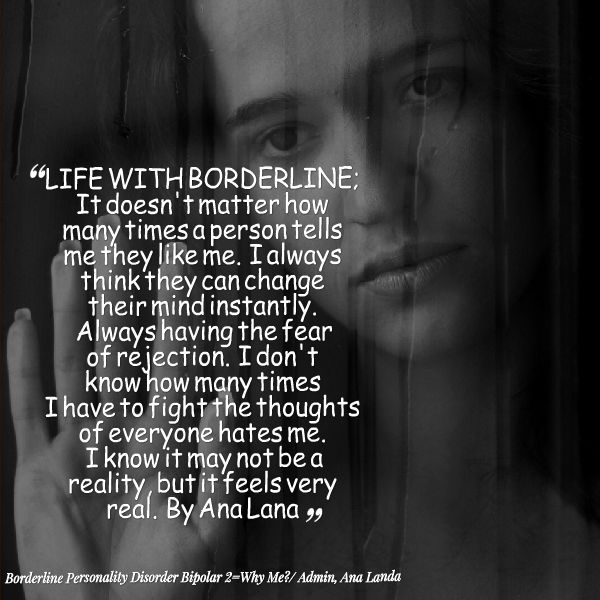 Moreover, anything can become a trigger: an incorrect statement on the part of the interlocutor, just an action that seemed wrong to me, or an opinion that is the opposite of mine. I can be aggressive even to banal questions about my well-being.
Moreover, anything can become a trigger: an incorrect statement on the part of the interlocutor, just an action that seemed wrong to me, or an opinion that is the opposite of mine. I can be aggressive even to banal questions about my well-being.
I try to warn people about the peculiarities of my behavior, I leave the dialogue if I feel that I am jumping into aggression, I try to distract myself. My psychotherapist advises to live through aggression and give it a way out: tear a sheet of paper, go in for sports, beat a pillow, shout.
/list/psychotherapevt/
10 important questions for psychotherapist Sergey Divisenko
Changes in interests, hobbies and desires. I don't have one hobby, they are constantly changing. I can't say what my favorite movie or music is. Because today I like one thing, and tomorrow I'm already interested in absolutely polar things. I never know in advance what awaits me the next day.
Suicidal thoughts and destructive behavior. For the first time I thought about suicide at the age of 14. Then these thoughts haunted me throughout my life. Somehow I lived with a gas leak in my apartment for several months, knowing full well about it. I drown my negative emotions in alcohol. I used to cut myself, but then I replaced this ritual with getting tattoos on my body.
Such thoughts are difficult to deal with. Medication, mindfulness and constant support from a psychotherapist help a little. I also sometimes go outside in the cold or take a shower: it's sobering.
Unstable self-esteem. I need a permanent evaluation from the outside. I doubt whether I am doing the right job, whether I look right if I do not receive feedback from people. Every mistake is a tragedy for me, but from praise I can feel capable of anything. I can spend weeks thinking that I did some wrong action, although it did not suffer consequences.
To cope with this, I try to compliment myself, remind myself what I'm doing and why, and look at the results of my work.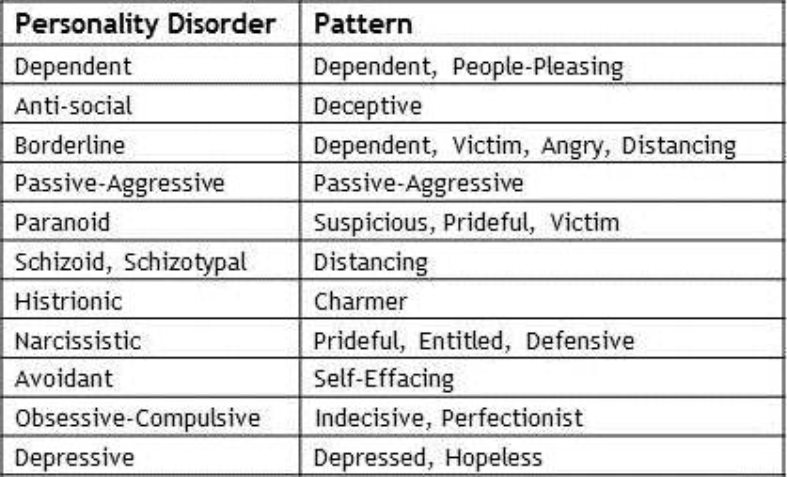 This does not always work, but here you need to take small steps and learn to focus on your feelings, and not just on others.
This does not always work, but here you need to take small steps and learn to focus on your feelings, and not just on others.
11 types of psychotherapy that work
Communication difficulties. I'm thrown from love to hate. I often conflict and change because of this place of work. In no relationship have I lasted more than a few months, and communication with friends is reduced to a couple of meetings a year. If I feel that I may be rejected or denied something, then I do it first to avoid emotions.
Everything that happens is always a disaster: vivid emotions, strong feelings of guilt. If I feel like I'm getting less attention, I'm hysterical. I immediately feel abandoned and abandoned. Considering my peculiarities of behavior, I always try to warn friends and relatives about my condition and tell how not to run into even more negativity.
How to better communicate with people who have borderline disorder
As with many people with BPD, the SET-UP method works well for me. There is about him in the book “I hate you, just don’t leave me. Borderline Personalities and How to Understand Them by Kreisman and Strauss.
There is about him in the book “I hate you, just don’t leave me. Borderline Personalities and How to Understand Them by Kreisman and Strauss.
6 useful services for finding a psychotherapist
SET stands for support, empathy, truth - support, sympathy, truth.
It is important that none of the parts can be thrown out of this communication triangle, otherwise the person with BPD will go into conflict or stop communication altogether:
- Support should be expressed in the form of concern in the first person: “I worry about how you are you feel." The main thing is to express your own feelings and sensations.
- Sympathy: "You must be feeling upset." It is important to validate the feelings of the person with BPD. Don't try to show pity or talk about how you feel the same way. Most likely, this is not the case. And the phrase "I know how bad you feel" will only cause ridicule and anger.
- Truth: you need to rely on the facts about the situation and not go into accusations.
 For example: “You quit, you have enough money for a couple of months. I can help by preparing your resume, and you will look for a new job.”
For example: “You quit, you have enough money for a couple of months. I can help by preparing your resume, and you will look for a new job.”
UP is understanding, perseverance, or understanding and perseverance. These are goals that both participants must achieve.
A person with BPD must become aware of the causes of his actions and their consequences. Understand that he influences his life and can change it. He needs perseverance in order not to give up treatment, because any changes are difficult.
For those close to a person with BPD, understanding is the recognition of a person's feelings and emotions. That is, the acceptance that negative statements and aggression are behavioral features. They need perseverance in order to continue communicating with a person with borderline disorder, not to stop reminding him of his readiness to help, to sober him up and help him find the true cause of events, rely on facts, and not let him focus only on emotions.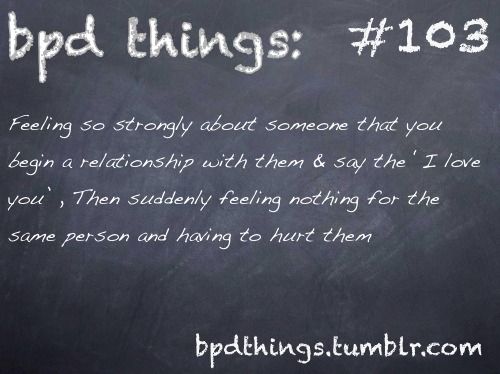
/shizofreniya/
How much does it cost to support a relative with a mental disorder
Communication with a person with BPD is always stressful, so people around need to take more care of themselves. It will take a lot of patience and strength to withstand sudden mood swings and maintain relationships.
The main thing is to understand that it is not your fault and you cannot influence BPD. However, if you remain in a stable state and support a person with a disorder, he will eventually cease to see his relatives as a potential threat, which means that there will be fewer outbreaks of aggression.
There is a resource center "Borderline Personality Disorder" in Russia. It is designed for Muscovites, but on the site you can find personal stories of people with BPD, literature on the topic and features of this disorder.
How much does it cost to treat borderline personality disorder? The psychotherapist told me that we would manage in a year.

I need to visit a psychotherapist every week, an appointment costs 6,000 R. In addition, every one and a half to two months I visit a psychiatrist, whose appointment also costs 6,000 R.
/prl/
How much does borderline personality disorder treatment cost? Since I have severe depressive episodes, I need to take pills for a long time: from the moment my condition becomes stable on the background of psychotherapy, it is another 6-12 months.
Now about 2000 R per month is spent on drugs. I often change pills, so the cost is approximate.
Drug treatment can remove symptoms that interfere with a normal life, and with the help of a course of psychotherapy, it will be possible to go into remission and significantly improve the quality of life. Relapses are extremely rare and are associated with affective states.
I spend 372,000 R per year for the treatment of borderline disorder
| Treatment | Expenses |
|---|---|
| Weekly psychotherapist visit | 312 000 R |
| Psychiatric visit every 2 months | 36 000 R |
| Medicines | 24 000 R |
Visiting a psychotherapist every week
312 000 R
Visit a psychiatrist once every 2 months
36 000 000 000 000 2 24 000 24 000 R
Is it possible to cure a border personality disorder
Aleksey Profitkov
0003
psychotherapist, psychiatrist, MD
We cannot completely eliminate the symptoms of borderline personality disorder.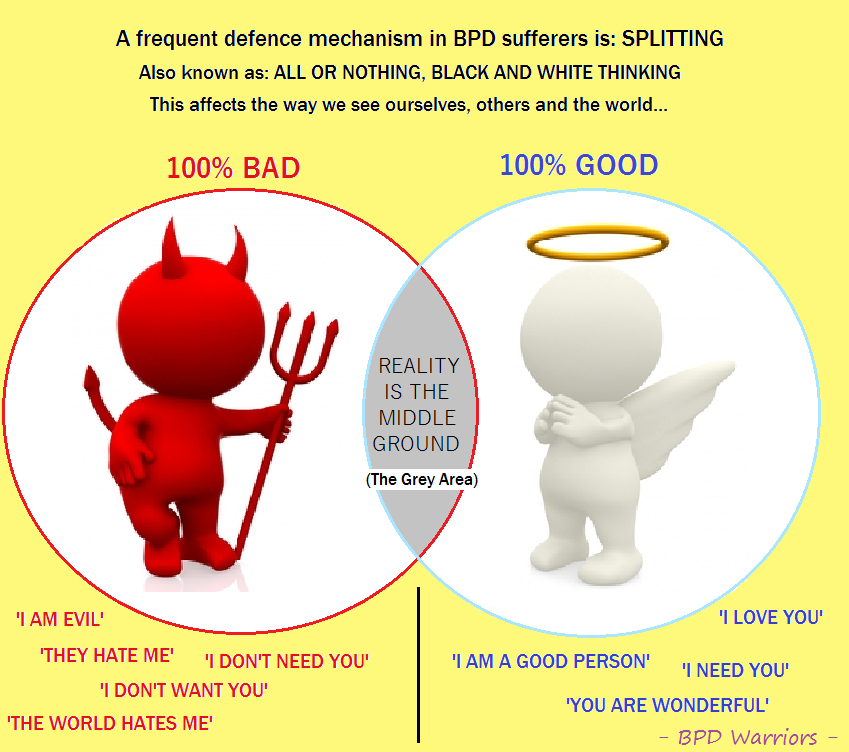 However, its manifestations can be smoothed out: pronounced negative traits can be corrected, some stability achieved, and social adaptation improved.
However, its manifestations can be smoothed out: pronounced negative traits can be corrected, some stability achieved, and social adaptation improved.
At the same time, the essence of personality cannot be changed, the characteristics of a person are preserved. In fact, the task of treatment is not to completely eliminate these features, but to teach a person to live with them, to clearly understand and manage them.
Remember
- Borderline personality disorder is characterized by unstable mood, fluctuations in self-esteem, dependency on the opinions of others, and an acute fear of being alone.
- The risk of developing BPD is increased by genetic factors, stress and violence in childhood, and poor attitude towards the child by significant adults.
- Borderline personality disorder is usually treated with psychotherapy, but medications may also be needed to relieve some of the symptoms and make life easier.
- It is difficult for close people to communicate with a person with BPD, you need a lot of patience to maintain a relationship.

- With the help of a course of psychotherapy, it can be possible to go into remission and significantly improve the quality of life.
Help for people with borderline personality disorder //Psychological newspaper
Psychologists and psychotherapists are often approached by people who, in the process of psychodiagnostics and initial interviews, have borderline personality disorder or "emotionally unstable personality disorder" according to ICD-10. What are its signs? How is life for people with page personality disorder? What do experts think about healing? What self-help techniques can people with BPD use in difficult situations? I will talk about this in the article.
Borderline personality disorder (BPD) is a group of personality disorders characterized by self-injurious behavior and difficulties in interpersonal relationships. Some people characterize BPD as "the apocalypse."
I highlight such signs of BPD as: constant anxiety, people with BPD may be anxious because of the crises that accompany their lives, changing events.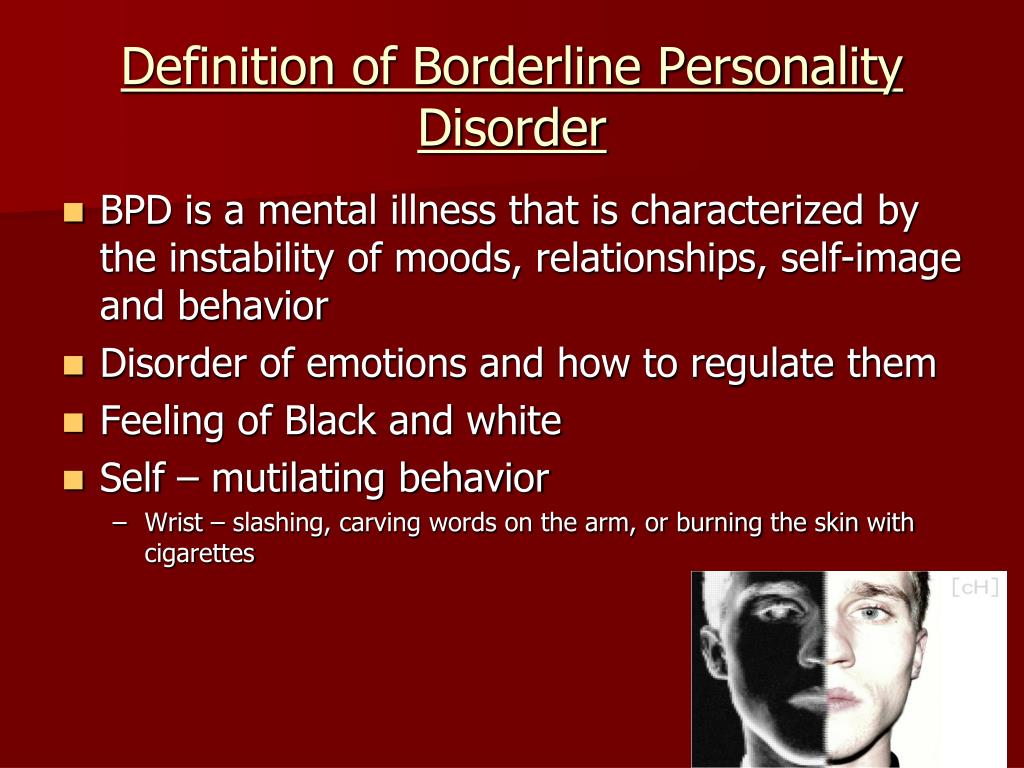 Often there is an alarming suspiciousness in connection with the state of health. Anxiety leads to psychosomatic illnesses, which reinforces the "vicious circle" - going to the doctors. Anxiety is associated with fear in the lives of people with BPD. A lot of things can scare them, these are new relationships, and intimacy, and parting, and other situations. Numerous spheres of life of people with BPD are “saturated” with fear, as in children aged 3-5 years, who are prone to various fears and anxieties. Especially fear and suspicion can increase in situations of stress. People with BPD have low self-esteem. It is as if a constant critic, distinguished by self-criticism, “sits” inside, and self-doubt and doubts are born from this.
Often there is an alarming suspiciousness in connection with the state of health. Anxiety leads to psychosomatic illnesses, which reinforces the "vicious circle" - going to the doctors. Anxiety is associated with fear in the lives of people with BPD. A lot of things can scare them, these are new relationships, and intimacy, and parting, and other situations. Numerous spheres of life of people with BPD are “saturated” with fear, as in children aged 3-5 years, who are prone to various fears and anxieties. Especially fear and suspicion can increase in situations of stress. People with BPD have low self-esteem. It is as if a constant critic, distinguished by self-criticism, “sits” inside, and self-doubt and doubts are born from this.
It is worth noting that it is difficult for people with BPD to answer the question: “who am I?”, “What do I want?”, The so-called diffuse identity manifests itself, where there are no strong goals, values and beliefs. When there is a series of events associated with parting with a loved one, with failures in work or in the sphere of relationships with others, which is typical for people with BPD due to emotional instability, emotional or mental pain arises - it resembles an uncomfortable feeling inside, close to despair. People with BPD may have problems controlling their emotions, which manifests itself in uncontrollable anger and anger, chronic conflicts with others. It is very difficult for them to be in a relationship with one partner for a long time, therefore, changes often occur in relationships, even some chaos, the search for more and more new partners.
People with BPD may have problems controlling their emotions, which manifests itself in uncontrollable anger and anger, chronic conflicts with others. It is very difficult for them to be in a relationship with one partner for a long time, therefore, changes often occur in relationships, even some chaos, the search for more and more new partners.
People with BPD tend to change jobs frequently. The work book is literally teeming with notes about various organizations in which I had to work. As a result, they may face certain difficulties in finding employment in the future. The litmus test for BPD in people's behavior is self-harm and suicide. At the same time, self-harm can manifest itself in different ways, from suicidal attempts to masochistic tendencies in behavior, when people with BPD want the other person to scold, offend, hurt. For some people with BPD, various kinds of addictions are characteristic, for example, alcoholism, drug addiction, gambling, Internet addiction. People with BPD are characterized by unreasonable spending of money, risky driving, and promiscuity. Often, after traumatic events, there may be problems with sleep, nightmares, obsessive thoughts about unpleasant situations, memories that disturb and do not allow you to live in peace. In general, the signs of BPD are characterized by polymorphism, and behavioral patterns - by a variety of manifestations.
People with BPD are characterized by unreasonable spending of money, risky driving, and promiscuity. Often, after traumatic events, there may be problems with sleep, nightmares, obsessive thoughts about unpleasant situations, memories that disturb and do not allow you to live in peace. In general, the signs of BPD are characterized by polymorphism, and behavioral patterns - by a variety of manifestations.
You can describe borderline personality disorder with the word: INSTABILITY, where:
N - hate. People with BPD are characterized by a feeling of hatred as a long, intense, negative feeling, reflecting disgust, hostility, rejection of someone.
E - Yeralash. Characterized by disorder, confusion, confusion. Chaotic interpersonal, incl. intimate relationships, lack of structure.
C - Self harm. Among people with BPD, there are suicide attempts, cutting, poisoning, self-harm with the help of other people in interpersonal relationships, self-infliction of pain.
T - Spending. Unreasonable spending of money on unnecessary purchases, unreasonable expenditure of effort.
A - Ambivalence. Opposite feelings in a short amount of time. For example, love and hate.
B - Pain. Characterized by mental pain with repeated unsuccessful attempts, for example, in building interpersonal relationships, employment, etc.
I - Idealization. The tendency to idealize other people and depreciate them after a short period of time.
L - Lie. People with BPD are prone to deceit, lies, embellishment of reality.
N - Troubles. People with BPD often find themselves in conflict situations, quarrels, unfriendly relationships.
Oh - emptiness. People with BPD often feel empty inside, lack of interest.
S - Boredom. A feeling of boredom, a decrease in activity, a lack of prolonged interest in any activity, the world around and other people are characteristic.
T - Branding, branding. They often brand themselves. After hospitalization in a hospital, they feel the stigma of the mentally ill, acutely experience such a state, and isolate themselves.
INSTABILITY characterizes the lives of people with BPD, these are interpersonal relationships, and situations related to employment, and mood, and behavior in general.
Expert opinions on borderline personality disorder
Anton Yezhov, PhD in Psychiatry. Institute of Neurology, Psychiatry and Narcology of the Academy of Sciences of Ukraine, Kharkiv, full member of the Russian Psychotherapeutic Association, certified and accredited by the Moscow Gestalt Institute (according to the standards of the European Association of Gestalt Therapists).
- Anton Vladimirovich, what is borderline personality disorder?
- In ICD-10: F60.3 it is “Emotionally labile personality disorder. Impulsive and borderline type. With borderline character disorder ( BPD), patients generally test reality, however, during diagnosis, there may be a slight distortion in the description of events occurring with the patient, as a result of a poorly developed ability for reflection, mentalization, the impact of strong affects and primitive defenses on cognitive processes. In some cases, there may be quasi-psychotic episodes in the form of short paranoid reactions, usually provoked by any dual and uncertain situation, as well as episodes of dissociation. But, as a rule, all these phenomena do not develop into stable delusional and hallucinatory symptoms. Patients with PPH also have a rather high suicidal risk, but the main motive is most often a demonstrative protest, jealousy, a desire to “punish” a partner and make him feel guilty. In PPH, rage, hatred, resentment dominate in suicidal behavior. Auto-aggressive actions are usually performed impulsively, at the peak of affect, often in a demonstrative style.
- How can BPD be corrected?
- In the therapy of CPH, the pathogenetic is long-term psychotherapy focused on the client-therapeutic relationship - this is the main type of treatment! Pharmacotherapy acts as a maintenance therapy. Drugs in the treatment of BPH include selective serotonin reuptake inhibitors, low dose antipsychotics, and mood stabilizers. The general approach in the pharmacotherapy of BPH is to reduce the unnecessary use of medications (!), medicating the target symptoms with an understanding of pharmacodynamics.
Irina Mlodik, Ph.D. in Psychology, psychologist, gestalt therapist, existential psychotherapist, author of books and articles on child and adult practical psychology, author's training courses.
- Irina Yurievna, please tell me, is it possible to recover from borderline personality disorder?
- About the treatment: it's hard to say. I do not have a psychiatric, not a medical position on this matter. I believe that in each of us there can be a borderline arranged and borderline functioning part. In that sense, there's no cure for the way you're made. One can only reduce the consequences of border effects. Including and mainly with the help of high-quality and long-term, for example, humanistically oriented or analytical psychotherapy. Long-term and regular therapy creates a special type of relationship with the therapist, which allows, being in high-quality and constant contact: to live through many difficult and not processed by the psyche affects from childhood, to create and maintain with the help of therapeutic contact an important, permanent, uninterrupted connection with the therapist (which there was almost certainly no person with BPD), who becomes an important “adult” in the life of a “border guard” who can be relied upon. Subsequently, from relying on the connection and the figure of the therapist, inside and the person with BPD, other relationships grow both inside themselves (to their internal objects) and outside, they have the opportunity to maintain closeness not only with the therapist, but also with other people and build with them a long-term relationship. Affects become rarer, not so amplitude, endurable. There is an opportunity to know one’s own painful places better, take care of oneself more, be less exposed to destructive relationships and processes, better understand one’s reactions, features and manifestations, learn to treat oneself like this in the world of people, sometimes explaining to them one’s own characteristics and properties.
Subsequently, from relying on the connection and the figure of the therapist, inside and the person with BPD, other relationships grow both inside themselves (to their internal objects) and outside, they have the opportunity to maintain closeness not only with the therapist, but also with other people and build with them a long-term relationship. Affects become rarer, not so amplitude, endurable. There is an opportunity to know one’s own painful places better, take care of oneself more, be less exposed to destructive relationships and processes, better understand one’s reactions, features and manifestations, learn to treat oneself like this in the world of people, sometimes explaining to them one’s own characteristics and properties.
Advice for People with BPD to Use in a Crisis
Calming an emotional storm
Stop fighting, avoiding, repressing, or denying what you are feeling. Give yourself permission to feel, this will take away the power of feelings over you.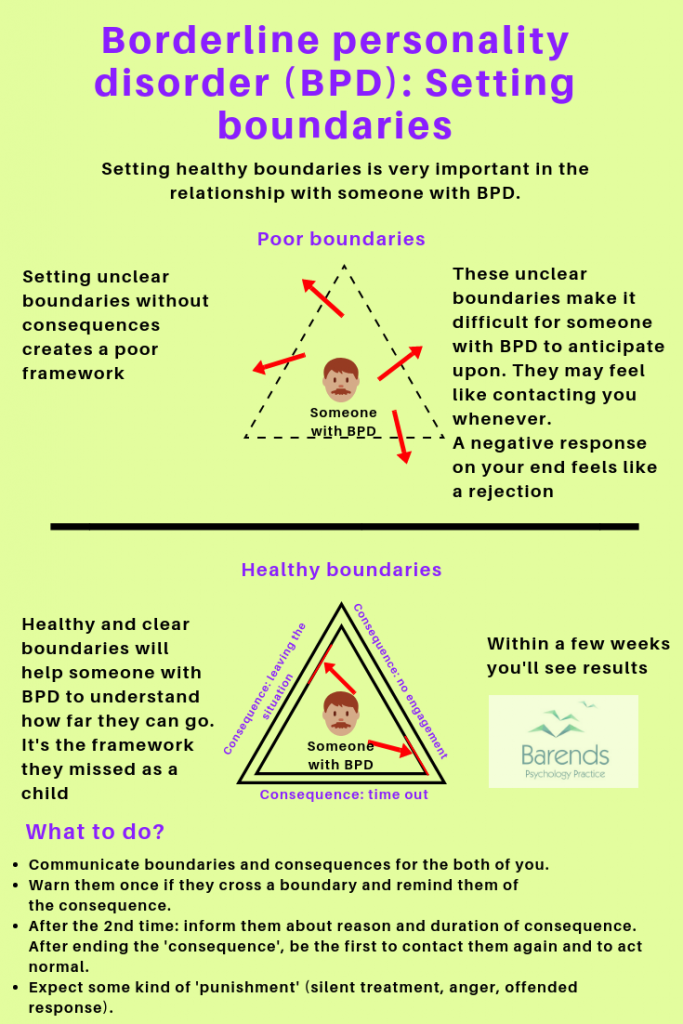 Try to simply experience your feelings without judgment or criticism.
Try to simply experience your feelings without judgment or criticism.
Awareness
Let go of the past and the future, focus solely on the present moment. Mindfulness techniques can be very effective in this regard.
• Start by observing your emotions, step back and just observe them.
• Watch them come and go (it can help to think of them as waves that come and go).
• Focus on physical sensations that are accompanied by emotions.
• Tell yourself that you accept your emotions, accept what you feel right now.
• Remind yourself that just because you feel something doesn't mean it's real.
Do something to change your bad feelings
You will need to experiment to find out what works best for you. What can help when you are angry or have very strong feelings, when you are depressed, etc.
Some ideas for self-improvement
Tactile sensations . Try running your hand in cold or hot (but not scalding) water; hold a piece of ice in your hand; grab the edge of the piece of furniture as hard as you can. If you're feeling anxious and need to calm down, try taking a hot bath or shower; cover yourself with a blanket or cuddle with a pet.
If you're feeling anxious and need to calm down, try taking a hot bath or shower; cover yourself with a blanket or cuddle with a pet.
Taste . If you feel empty or bored inside, try putting strong flavored sweets or mints in your mouth, slowly eating something with an intense taste, such as something salty. If you want to calm down, try something calming like hot tea or soup.
Smell . Light a candle, smell the flowers, try aromatherapy, spritz on your favorite perfume, or smell something that smells good in the kitchen. You may find you respond best to strong odors such as citrus, spices, etc.
Landmark . Focus on an image that grabs your attention. It could be something in your immediate environment (a great view, a beautiful flower, the location of a building, a favorite painting or photo) or something you imagine.
Sound . Try listening to loud music or a bell or whistle when you need a boost. To calm down, play soothing music or listen to soothing sounds of nature such as the wind, birds, or the ocean.




